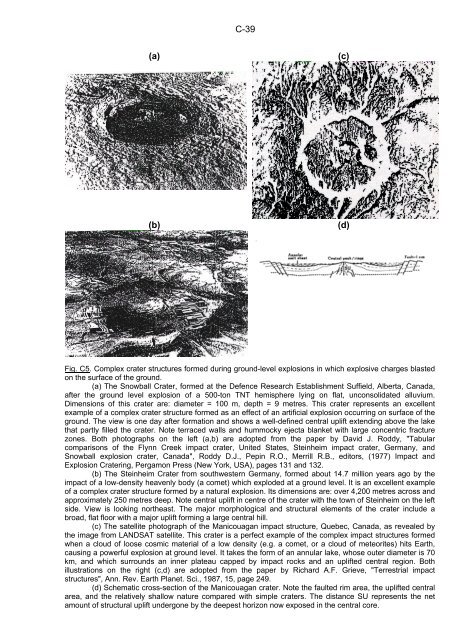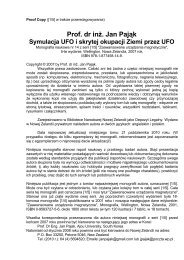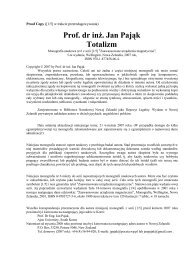Prof. Dr Jan Pajak THE NEW ZEALAND EXPLOSION OF ... - Totalizm
Prof. Dr Jan Pajak THE NEW ZEALAND EXPLOSION OF ... - Totalizm
Prof. Dr Jan Pajak THE NEW ZEALAND EXPLOSION OF ... - Totalizm
- No tags were found...
Create successful ePaper yourself
Turn your PDF publications into a flip-book with our unique Google optimized e-Paper software.
C-39(a)(c)(b)(d)Fig. C5. Complex crater structures formed during ground-level explosions in which explosive charges blastedon the surface of the ground.(a) The Snowball Crater, formed at the Defence Research Establishment Suffield, Alberta, Canada,after the ground level explosion of a 500-ton TNT hemisphere lying on flat, unconsolidated alluvium.Dimensions of this crater are: diameter = 100 m, depth = 9 metres. This crater represents an excellentexample of a complex crater structure formed as an effect of an artificial explosion occurring on surface of theground. The view is one day after formation and shows a well-defined central uplift extending above the lakethat partly filled the crater. Note terraced walls and hummocky ejecta blanket with large concentric fracturezones. Both photographs on the left (a,b) are adopted from the paper by David J. Roddy, "Tabularcomparisons of the Flynn Creek impact crater, United States, Steinheim impact crater, Germany, andSnowball explosion crater, Canada", Roddy D.J., Pepin R.O., Merrill R.B., editors, (1977) Impact andExplosion Cratering, Pergamon Press (New York, USA), pages 131 and 132.(b) The Steinheim Crater from southwestern Germany, formed about 14.7 million years ago by theimpact of a low-density heavenly body (a comet) which exploded at a ground level. It is an excellent exampleof a complex crater structure formed by a natural explosion. Its dimensions are: over 4,200 metres across andapproximately 250 metres deep. Note central uplift in centre of the crater with the town of Steinheim on the leftside. View is looking northeast. The major morphological and structural elements of the crater include abroad, flat floor with a major uplift forming a large central hill.(c) The satellite photograph of the Manicouagan impact structure, Quebec, Canada, as revealed bythe image from LANDSAT satellite. This crater is a perfect example of the complex impact structures formedwhen a cloud of loose cosmic material of a low density (e.g. a comet, or a cloud of meteorites) hits Earth,causing a powerful explosion at ground level. It takes the form of an annular lake, whose outer diameter is 70km, and which surrounds an inner plateau capped by impact rocks and an uplifted central region. Bothillustrations on the right (c,d) are adopted from the paper by Richard A.F. Grieve, "Terrestrial impactstructures", Ann. Rev. Earth Planet. Sci., 1987, 15, page 249.(d) Schematic cross-section of the Manicouagan crater. Note the faulted rim area, the uplifted centralarea, and the relatively shallow nature compared with simple craters. The distance SU represents the netamount of structural uplift undergone by the deepest horizon now exposed in the central core.










![[1/4p]: PDF - Totalizm](https://img.yumpu.com/45003232/1/184x260/1-4p-pdf-totalizm.jpg?quality=85)




![[1/4p]: PDF - Totalizm](https://img.yumpu.com/39351336/1/184x260/1-4p-pdf-totalizm.jpg?quality=85)
